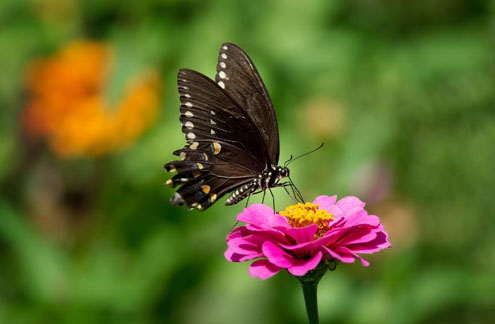Butterflies serve as plant pollinators and lovely, ephemeral visions as they pass through our landscape. To attract more butterflies to your yard, you can create a special garden with the floral nectar sources they need. Butterfly gardens attract and sustain butterflies, allowing them to complete their life cycle while also pollinating plants.
There are two types of plants required by butterflies: host plants where females lay eggs and the butterfly larvae feed and nectar-producing flowers that provide a vital food supply for adult butterflies. When creating your butterfly garden, it is best to have groups of flowers rather than individual plants because adult butterflies are near-sighted and can see groupings of flowers more easily than individual plants.

Different species prefer to feed on specific nectar plants, largely dependent on their different proboscis lengths. Offering a nearby border of dense shrubs can protect the fragile butterflies from predators as well as presenting an option for caterpillar metamorphosis.
Adult butterflies are attracted to red, yellow, orange, and pink blossoms.
Molly Keck, AgriLife Extension entomologist in Bexar County recommends any of the following flower varieties to attract butterflies to your yard: Pride of Barbados, Henry Duelberg salvia, Mystic Spires blue salvia, New Gold lantana, Butterfly deep pink pentas, zinnias, Turk’s cap and Gregg’s mistflower.
Other flowering plants enjoyed by butterflies include Bee Balm, Purple Coneflower, and Butterfly weed.
When selecting plants for your butterfly garden, choose plants that bloom at different times of the year so that there is almost always something appealing to them. Although some exotic plants will attract butterflies, choosing native plants when possible is a better alternative to match the needs of the butterflies that are found in our area. The Native Plant Society of Texas provides a list of native plants by ecoregion. To see their list for the North Central Texas ecoregion, go to NPSOT.org, select “Search for Plants” and then download the list for our ecoregion.
In addition to offering the appropriate nectar-producing plants and host plants, your butterfly garden should include a water source for the butterflies. A good water source can be a shallow dish filled with coarse sand, a bit of manure, and a few flat stones for the butterflies to stand on. If you search on the internet for “butterfly puddler”, you will see examples and instructions to make your own.
Here are some additional resources to help you attract butterflies to your yard:
From Tarrant County Save the Water: you will find a list of 10 common butterflies seen in North Texas
gardens: https://savetarrantwater.com/butterflies-of-north-texas/
The Elm Fork Chapter of the Texas Master Naturalists provides a plant list matching several types of locally seen butterflies with a list of their favorite larval foods and nectar sources. To find their information, go to txmn.org and search for butterflies.
The butterfly population is declining by about 1.5% per year since 1977. Please do your part to help them survive.
Happy Gardening!

